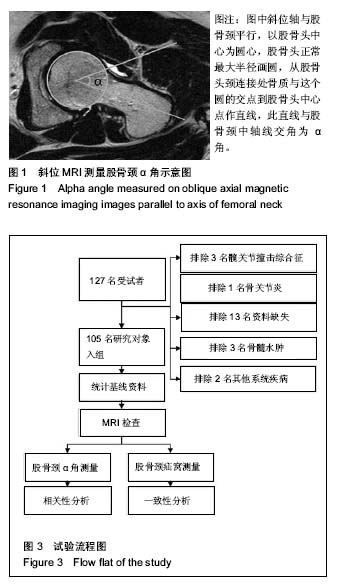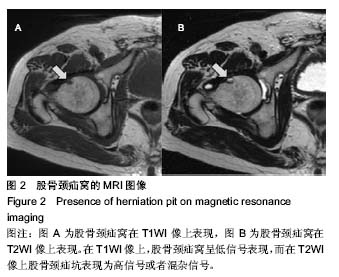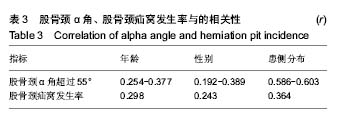| [1] 张毅, 姚伟武. 髋关节撞击综合征的MSCT测量与分析[J]. 中国医学计算机成像杂志, 2015, 21(2):159-163.[2] 刘骞, 王万春. Cam型髋关节撞击综合征关节软骨接触力学的有限元分析[J]. 医用生物力学, 2015, 30(3):203-208.[3] 臧建成, 张洪. 成人髋关节发育不良的髋关节撞击综合征[J]. 中华骨科杂志, 2014, 34(12):1252-1257.[4] Chládek P, Musálek M, Tr? T, et al. Femoroacetabular impingement syndrome-efficacy of surgical treatment with regards to age and basic diagnosis. Int Orthop. 2015;39(3): 417-422.[5] Gil AB, Blanco RL, Rada PD. Validity of magnetic resonance arthrography as a diagnostic tool in femoroacetabular impingement syndrome. Revista Espanola De Cirugia Ortopedica Y Traumatologia. 2015;59(4):281-286.[6] Lerch S, Kasperczyk A, Berndt T, et al. Ultrasonography can quantify the extent of osteochondroplasty after treatment of Cam-type femoroacetabular impingement. Int Orthop. 2015; 39(5):853-858.[7] Kuhns BD, Weber AE, Levy DM, et al. The Natural History of Femoroacetabular Impingement. Front Surg. 2015; 2(2):58.[8] Rafols C, Monckeberg JE, Numair J. Unusual Bilateral Rim Fracture in Femoroacetabular Impingement. Case Rep Orthop. 2015;2015:210827.[9] 熊元, 赵振国, 邹亮,等. 髋关节撞击综合征诊断与治疗的研究进展[J]. 中国骨与关节杂志, 2014, 13(6):443-446.[10] 张毅, 姚伟武. 髋关节撞击综合征影像学诊断进展[J]. 诊断学理论与实践, 2015,14(1):66-70.[11] 赵宝祥, 马扩助, 邹季. 髋关节撞击综合征研究概述[J]. 风湿病与关节炎, 2014,3(9):45-48.[12] Salvador G, Christoforetti JJ, Zoric B. Femoroacetabular Impingement: Labrum, Articular Cartilage// MRI-Arthroscopy Correlations. 2015.[13] Heiderscheit B, Mcclinton S. Evaluation and Management of Hip and Pelvis Injuries. Phys Med Rehabil Clin North Am. 2016;27(1):1-29.[14] Subas? DI, Sunar M, Karakaya DA, et al. Femoroacetabular impingement syndrome: magnetic resonance imaging findings. Anat Int J Exp Clin Anat. 2014.[15] Rego PR, Mascarenhas V, Oliveira FS, et al. Morphologic and angular planning for cam resection in femoro-acetabular impingement: value of the omega angle. Int Orthop. 2015; 1(2):1-7.[16] Lahner M, Jahnke NL, Zirke S, et al. The deviation of the mechanical leg axis correlates with an increased hip alpha angle and could be a predictor of femoroacetabular impingement. Int Orthop. 2014;38(1):19-25.[17] Odri GA, Frioux R, Redon H, et al. Reliability of a new hip lateral view to quantify alpha angle in femoroacetabular impingement. Orthop Traumatol Surg Res. 2014;100(4): 363-367.[18] 吴慧钊, 宋岩, 吴文娟,等. 髋关节功能位数字化断层融合成像观察髋关节撞击综合征相关征象的价值[J]. 临床放射学杂志, 2015, 34(5):759-763.[19] 黄耀渠, 李均洪, 梁振华,等. 股骨颈疝窝与股骨髋臼撞击综合征相关解剖学异常的多层螺旋CT研究[J]. 中华解剖与临床杂志, 2016, 21(1):18-21.[20] 张志强. 成人股骨颈疝窝的发生率及影像学特征[J]. 中国实用医药, 2016, 11(25):15-16.[21] Mathew G, Kowalczuk M, Hetaimish B, et al. Radiographic prevalence of CAM-type femoroacetabular impingement after open reduction and internal fixation of femoral neck fracture. Knee Surg Sports Traumatol Arthrosc. 2014;22(4):1-8.[22] Satpathy J, Kannan A, Owen JR, et al. Hip contact stress and femoral neck retroversion: a biomechanical study to evaluate implication of femoroacetabular impingement. J Hip Preserv Surg. 2015;2(3):287-294.[23] Mainzer J, Ganz R, Tibor L, et al. Not All Hip Pain Is Impingement: Femoral Neck Osteoid Osteoma in a Patient with a Coexisting Cam Deformity: A Case Report. Case Connector. 2014;2(3):e31-e31.[24] Duff MJ, Johnson AJ, Wassef AJ, et al. Does Femoral Neck to Cup Impingement Affect Metal Ion Levels in Hip Resurfacing? Clin Orthop Relat Res. 2014;472(2):489-496.[25] Chaudhary MM, Chaudhary IM, Vikas KN, et al. Surgical hip dislocation for treatment of cam femoroacetabular impingement. Indian J Orthop. 2014;49(5):496-501.[26] Zammit A. Femoroacetabular impingement (FAI) syndrome-The medical imaging perspective. Malta Med J. 2014;26(1):23-31.[27] Guo Z, Xu L, Su YB, et al. Correlation between the prevalence of herniation pits and the alpha angle of the hip: computed tomography evaluation in healthy Chinese adults. Bmc Musculoskeletal Disorders. 2013;14(1):1-5.[28] 黄耀渠, 李均洪, 梁振华,等. 股骨颈疝窝与股骨髋臼撞击综合征相关解剖学异常的多层螺旋CT研究[J]. 中华解剖与临床杂志, 2016, 21(1):18-21.[29] 张士文, 曲源, 候秋萍. 髋关节撞击综合征的影像学表现[J]. 现代医用影像学, 2014, 23(4):379-381.[30] Scheyerer MJ, Copeland CE, Stromberg J, et al. Radiographic markers of femoroacetabular impingement: correlation of herniation pit and femoral bump with a positive cross-over ratio. Adv Orthop. 2014;2014(417):1-5.[31] Naal FD, Dalla RF, Wuerz TH, et al. Sonographic prevalence of groin hernias and adductor tendinopathy in patients with femoroacetabular impingement. Am J Sports Med. 2015.[32] Darren de SA, Urquhart N, Philippon M, et al. Alpha angle correction in femoroacetabular impingement. Knee Surg Sports Traumatol Arthrosc.2014;22(4):812-821.[33] 周春香, 孟悛非. 髋关节撞击综合征[J]. 国际医学放射学杂志, 2007, 30(6):414-417.[34] 肖凯, 张洪. 股骨颈前倾角对髋关节发育不良患者临床症状及治疗策略的影响[J]. 中华骨科杂志, 2014, 34(12):1258-1263.[35] 吴慧钊. 数字化断层融合技术观察髋关节撞击综合征相关征象的价值[D]. 河北医科大学, 2014.[36] 杨涛, 曾卫珊, 王学松,等. 钳夹型髋关节撞击综合征的影像学表现[J]. 实用放射学杂志, 2013, 29(6):970-989.[37] 卓鸿武, 冯华, 王雪松,等. 钳夹型髋关节撞击综合征术后残存骨性撞击的三维CT量化研究[J]. 中华骨科杂志, 2015, 35(3): 227-233.[38] Frank JM, Harris JD, Erickson BJ, et al. Prevalence of Femoroacetabular Impingement Imaging Findings in Asymptomatic Volunteers: A Systematic Review. Arthrosc J Arthrosc Relat Surg. 2015;31(6):13-26.[39] Byrd JW. Femoroacetabular Impingement in Athletes Current Concepts. Am J Sports Med. 2014;42(3):737-751.[40] Zaltz I, Kelly BT, Larson CM, et al. Surgical Treatment of Femoroacetabular Impingement: What Are the Limits of Hip Arthroscopy? Arthrosc J Arthrosc Relat Surg. 2014;30(1): 99-110. |
.jpg) 文题释义:
文题释义:



.jpg)
.jpg) 文题释义:
文题释义: